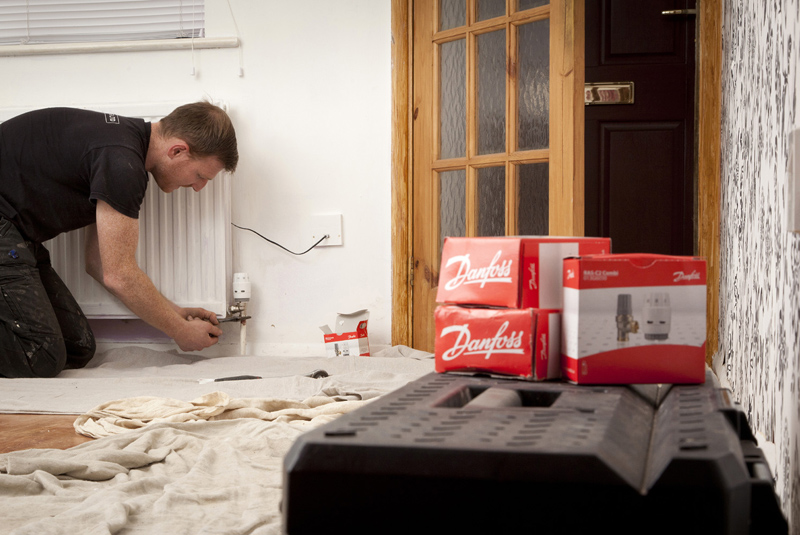
Gareth Ash, Marketing and Technical Support Manager at Danfoss, explains how fitting TRVs provides a simple way for installers to boost boiler efficiency and achieve increased energy savings for their customers.
In a high proportion of UK homes, the heating system consists of a boiler, most likely a gas-fired combi, and radiators. In fact, according to a study into energy use and heating costs in EU homes by the European Building Automation Controls Association, around 26 million houses in the UK have a ‘wet’ central heating system, which is among the highest in the EU. The study also found that when such systems are configured correctly with self-regulating devices that control the temperature in each room, occupants can reduce their fuel consumption and heating costs.
So it’s not surprising that in these times of increased focus on domestic energy efficiency, the EU has updated the European Performance of Buildings Directive (EPBD) and made these self-regulating devices mandatory. Under the new EPBD individual room controls, such as self-acting thermostatic radiator valves (TRV), are now required if technically and economically feasible: and if they are not present in existing homes with radiators they should be fitted when the boiler is replaced.
Simple solution
The introduction of the new EPDB followed a review of existing energy efficiency Directives which found that relatively low cost solutions, such as hydraulic balancing of the heating system and the installation or replacement of thermostatic control valves, were insufficiently considered. At Danfoss, we believe EPBD recognition of the energy saving value of TRVs is good news for the industry and end-users.
Properly selected and installed, modern TRVs from leading manufacturers like Danfoss provide a simple and cost-effective solution to EPBD compliance. They offer an easy-to-install, technical solution for heating engineers and an affordable investment for their customers with an estimated payback period of just two heating seasons. We therefore urge installers to actively promote these benefits to their customers so more households can reduce their carbon footprint and heating bills.
Condensing efficiency
Among the key energy saving benefits of TRVs is increased condensing boiler efficiency. To maximise the efficiency of a condensing boiler it is critical that the boiler operates in condensing mode most of the time. As soon as the boiler goes from non-condensing to condensing mode the efficiency skyrockets. Getting the boiler into this mode requires a return temperature of below 55°C. A regular manual radiator valve will keep the flow constant and the return temperature high. The principle of TRVs is to reduce flow by regulating room temperature to a desired temperature setpoint. This results in a lower return temperature which, in turn, increases condensing boiler efficiency. Typically, in a wet heating system with manual radiator valves the boiler will only operate in condensing mode about 5% of the time, compared with 80% if TRVs are fitted. There is, therefore, a significant boost in operational efficiency in a heating system with TRVs.
Part L review
Originally anticipated in late 2019, the next review of Part L of Building Regulations (England and Wales) relating to energy efficiency is now expected in 2020. The review could well follow the new EPDB and make TRVs not simply ‘best practice’ but a mandatory requirement (where feasible) for any new or replacement boiler installation. This would further enforce the proven benefits of installing TRVs and bring more affordable, energy efficient heating to millions of households around the UK.
However welcome, we also understand that legislative changes can be a challenge for busy heating professionals. That’s why we are committed to helping installers achieve compliance by offering a wide range of high efficiency heating controls, as well as useful technical advice and support. The latter now includes a new online Installer Hub purpose-designed by Danfoss to make installers’ lives easier. This new web resource is packed with information about free training, handy ‘how to’ videos, and product news, including the latest smart TRV developments – and all in one place at the click of a mouse.
Reduce overflows
As part of a hydronically balanced system, TRVs will also prevent unwanted overflows, and wasted energy, through the radiators. According to some figures, this could bring up to 36% of extra savings for homeowners compared with constantly open manual valves. In addition to the potential savings in fuel consumption and costs, investing in TRVs will also increase comfort for homeowners by providing accurate temperature control in each room of the house.
Watch the Danfoss video on how TRVs can increase boiler efficiency…












